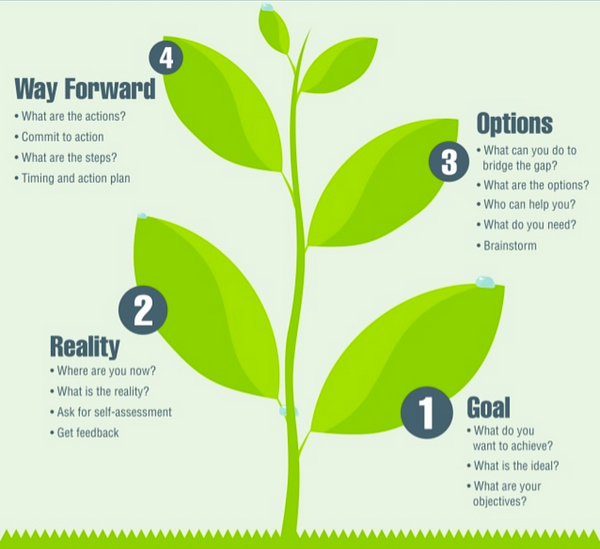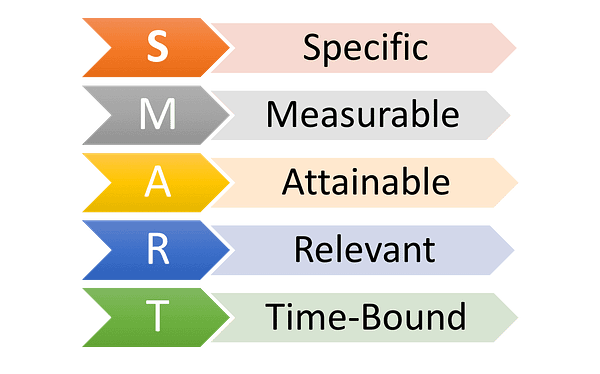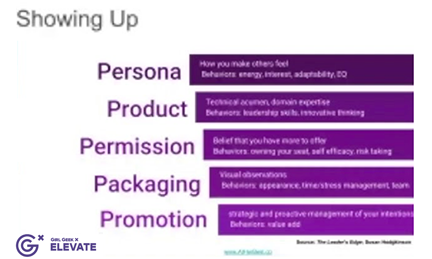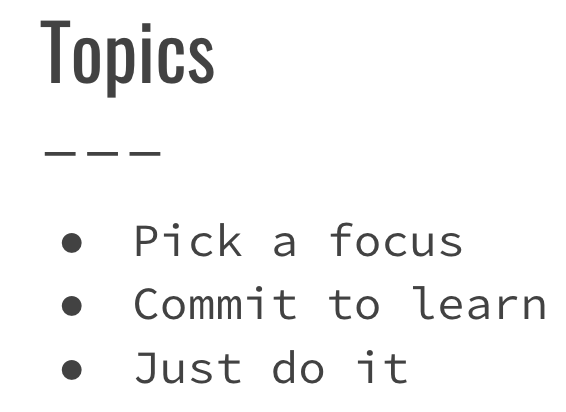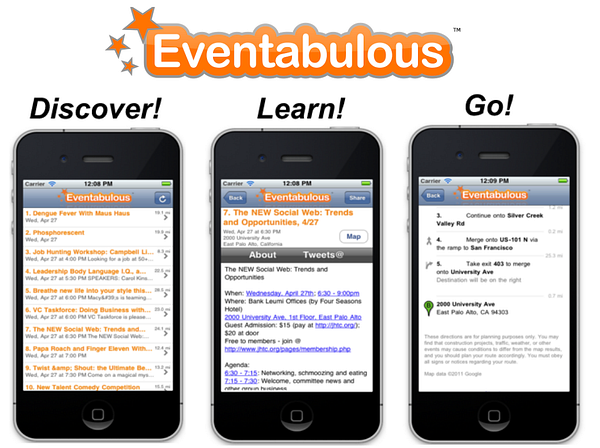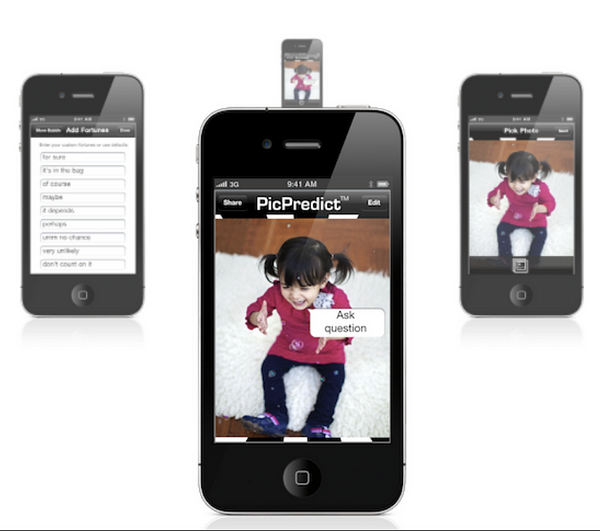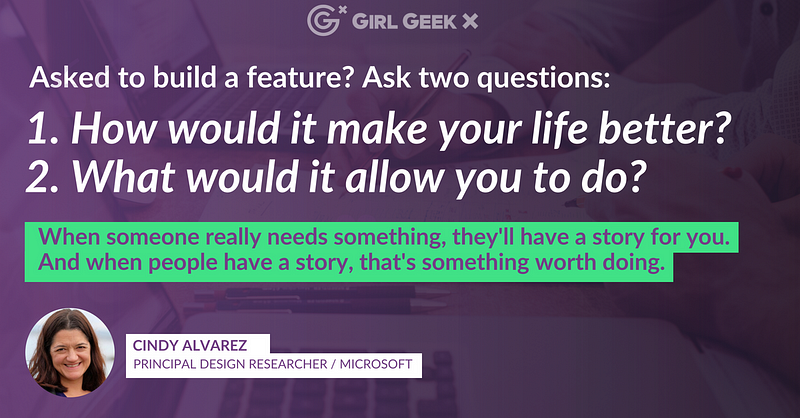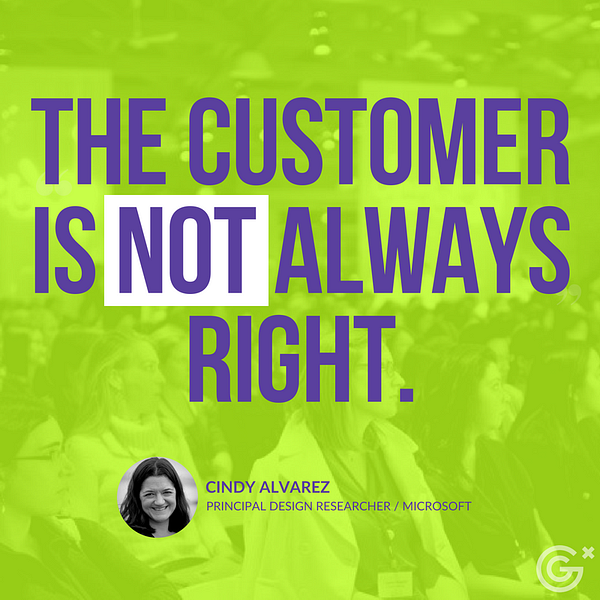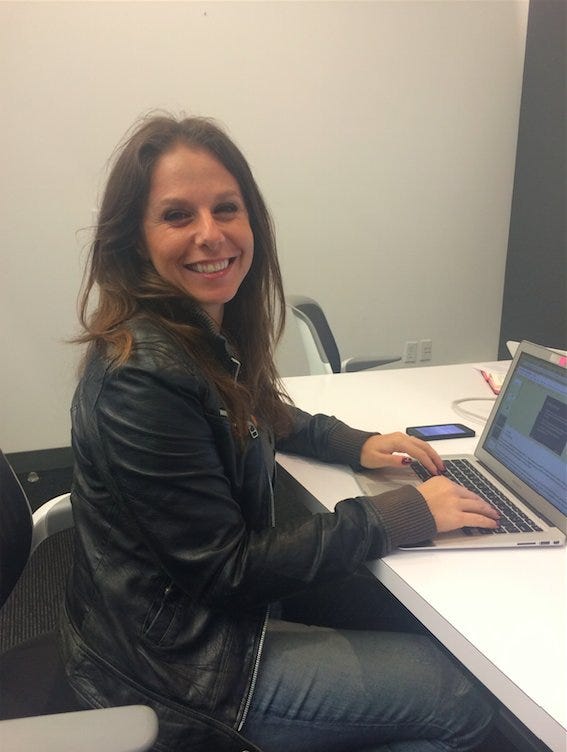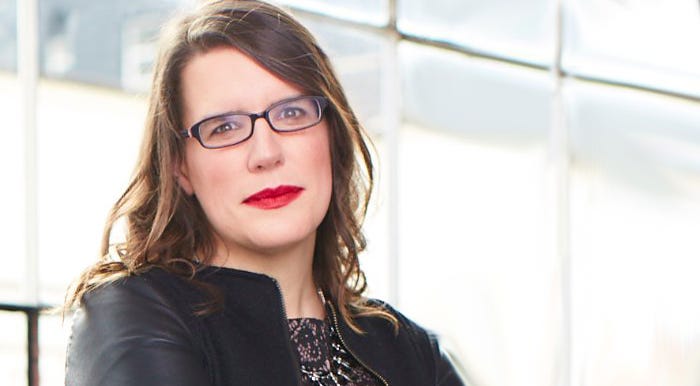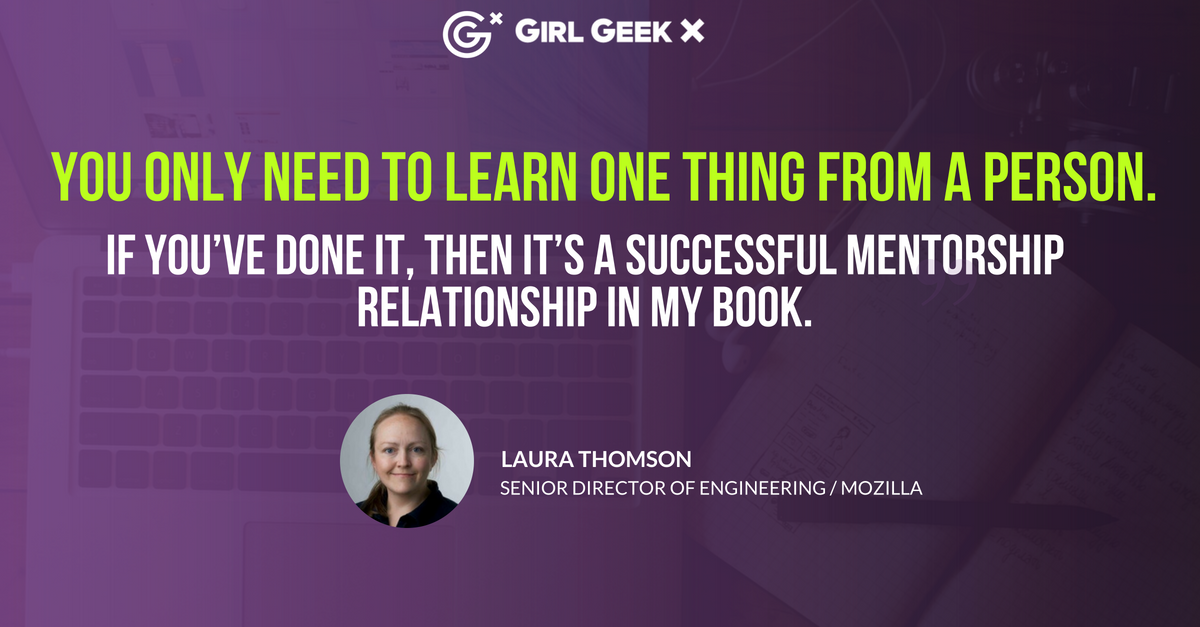Panelists:
Shanea King-Roberson / Senior Technical Product Manager / eBay
Claire Vo / VP, Product / Optimizely
Selina Tobaccowala / CEO & Founder / Gixo/Evite
Sarah Allen / Founder / RailsBridge & Engineering Manager / Google
Transcript
Shanea King-Roberson: Okay, I think we’re live everyone. So I’ll get started since we’re running a little bit late.
Shanea King-Roberson: Hi. My name is Shanea. I’m going to be the moderator today for, “What Happens After Your Startup Gets Acquired?” And since we’re running a little short on time, I’d love to have each one of our panelists take 30 seconds to introduce themselves, let everybody know what the company they had acquired is, and what they’re doing now.
Claire Vo: I’m Clair Vo. I am currently the VP of Product at Optimizely and I was the CEO and co-founder of a company called Experiment Engine that was acquired a year and one day ago, by Optimizely. We at Experiment Engine built solutions for enterprise customers to scale and manage their experimentation programs and that has been recently, as of January, re-released as part of the Optimizely platform as Optimizely Program Management, which top enterprises use to collaborate, manage, and report on their high velocity experimentation programs.
Shanea King-Roberson: Awesome. Thanks, Claire. Next.
Selina Tobaccowala: Hi, I’m Selina Tobaccowala. I’m the CEO and Co-founder of Gixo. We do live coach fitness classes right from your phone. In terms of previous startups, I had started Evite, with actually the same co-founder from Gixo, about two decades ago. So, the only reason you don’t see gray hair is ’cause it’s been dyed. But, we got acquired by Interactive Corp.
Selina Tobaccowala: And then on the other side of the table, I was at Ticketmaster and did about ten acquisitions and was the President and CTO at SurveyMonkey and also did a number of acquisitions there. So I have experiences both sides of the table.
Shanea King-Roberson: Awesome.
Sarah Allen: So my name is Sarah Allen. The first company I co-founded was straight out of school, was The Company of Science and Art, which was acquired … created After Effects was acquired by Aldus in ’93, then subsequently by Adobe in ’94. And then more recently I founded Blazing Cloud, which was a consultancy founded in 2009 and it was acqu-hired by Indiegogo in 2013. So the team joined Indiegogo.
Sarah Allen: I’m now at Google as an engineering manager, leading some teams doing server list events for serverless compute and a security policy.
Shanea King-Roberson: Awesome. And I guess I should probably go, too.
Shanea King-Roberson: I currently today am a senior technical product manager at Ebay and before that I was a product manager at Google and I started a digital marketing agency doing digital marketing and web development for women entrepreneurs, experts, and authors that I sold my half of the company to a different partner. So, I’m happy to be here. And we can jump right in.
Shanea King-Roberson: So, I’d love to quickly go over the types of acquisitions. So what are kind of the buckets in which an acquisition could fall on, or why you would like to get acquired.
Shanea King-Roberson: Let’s do that.
Selina Tobaccowala: Sure. Did you want one of us to start, or-
Shanea King-Roberson: Yes. Yes.
Selina Tobaccowala: Okay, sure, I can walk through in terms of … So, there’re different reasons, especially as an acquiring company, why you might want to acquire a company. I mean, the first is an acquihire, where you really wanna get the talent and that’s one type of acquisition.
Selina Tobaccowala: The second is when it’s what called accretive, which is where either the revenue is growing faster, the user growth is growing faster, than the core company, and so that’s where you essentially are buying it for the financial or business value.
Selina Tobaccowala: And a third situation is really if it’s like a strategic option for a product area or product advancement that you want to, essentially, go do. Which is, you’re sort of a small business and now you’re bringing somebody in who’s giving you enterprise experience. Or there’s different strategic tie-ins or fit-ins.
Selina Tobaccowala: And those will generally be the main sort of, philosophies around acquisitions.
Shanea King-Roberson: Awesome. That’s great.
Shanea King-Roberson: So what I’d love to do is if anyone on the line as any questions, feel free to put them in and we can have about ten minutes of Q&A at the end. But, I’m going to ask, starting from pre-acquisition.
Shanea King-Roberson: So there are people on the line that are in different stages of their careers and founding of their companies, so what are some of the ways that you can be prepared to be acquired before you’re ready? What are some of the things that entrepreneurs on the line should be thinking about, before they ever start to get acquired?
Shanea King-Roberson: How about Claire, you take this one.
Claire Vo: Yeah, so I think … Actually, somebody asked me that question a while ago. Like, “What should you do if you want to sell your company?” And I was like, “If you want to sell your company, you’re not in a great place to sell your company.” So, almost, if you are preparing to be acquired before you’re, quote, unquote, “ready,” you’re probably not focused on the right things.
Claire Vo: So what I would say is, the best preparation for an acquisition is a highly functional, value-generating, company. And so, the thing that you should do is try to maximize the value of your business by focusing on customers, growing revenue, reducing friction in whatever marketing or sales funnels you have, and ultimately building a valuable asset that somebody would want to acquire.
Claire Vo: I think the things that lead to a good business are going to lead to healthy acquisitions, and so you actually … I don’t recommend you do anything special, if you’re not intending to be acquired or aren’t ready to be acquired, that you wouldn’t already do to make your business valuable.
Shanea King-Roberson: Awesome.
Sarah Allen: So yeah, I wanted to-
Selina Tobaccowala: I would absolutely plus one that, with kind of the one exception being, trying to really make sure that way before you get acquired, you have a conversation with your co founder, if you have any, about what is either that number or what is that situation that you want to be acquired? Because it’s very different in the heat of the moment when people are coming to you and really making sure that you have sort of that baseline understanding with your founders of, are we trying to build this into a multi billion dollar company? If we get an offer for … If somebody comes in tomorrow … For a hundred million dollars, would we take it? Or, is it 15 million dollars? And having that conversation upfront, because what you don’t want to do is when something … If somebody approaches you, be on very different pages with your founding team.
Sarah Allen: Yeah, I was gonna chime in. Can you hear me?
Shanea King-Roberson: Mm-hmm (affirmative). We can hear you.
Sarah Allen: I was gonna chime in on that too. I think that people who are founding their company for the first time, don’t necessarily think through all the different things that might happen, and while you might be starting to be an independent company that IPOs, having a frank conversation with your co founders is like, “Well, what if it’s year five, and we expected to have this big outcome in year three, how are we going to feel about it? How are we gonna value what we’re doing? How will we handle that situation together? Because having that pre-conversation, like you mentioned, is where you can have a really healthy discourse around that, rather than waiting until your co founder is burned out, and they’re ready to quit and then you’re stuck with a company that is maybe on the verge of profitability but not doing everything you want. You want to be doing it together.
Sarah Allen: And of course, the best way to get sold is to … Or the best way to go into any of these situations, is to be in a great situation. But sometimes, just to be honest, people sell their companies when things aren’t going so well.
Shanea King-Roberson: Awesome. Those are really, really, great answers. Thanks.
Shanea King-Roberson: Since we’re kind of in this pre-acquisition conversation, I would love to take the flip side of this. So, what does the acquiring company look for that entrepreneurs today should be aware of?
Shanea King-Roberson: So if I’m a company and I want to acquire another company, what are some of those things? What are they looking for? What are some of the big ticket items that an entrepreneur should be building for?
Claire Vo: I think they’re reflected in the types of acquisitions that were described at the beginning of this session, which is actually like, will acquiring this company net us ROI positive in terms of revenue? Will it add strategic value to my product portfolio or my company portfolio, or does it add talent that’s otherwise difficult or expensive to acquire and retain?
Claire Vo: I think those are pretty simple. They’re looking for money. They’re looking for strategic advantage and they’re looking for talent. I can actually … There’s no like secret sauce [inaudible 00:09:05] a company’s looking for, other than to generate value for shareholders, and so those are the three things that can do that most directly.
Sarah Allen: Well I think to … There is another nuance to it. What you say is absolutely correct. The other thing is, they want to have … They’re looking for a company that’s gonna be successful in bringing that value to the new entity. And so, one of the things that both sides need to know is what’s the culture of the company that’s being acquired? Is it where the bigger company wants to go, or is it substantially different in a way that the acquired team is gonna have to adapt?
Sarah Allen: And that’s something where … Nobody acquires a company because they think it’s going to not go well, yet, a lot of times, the goals of the acquisition aren’t met, right? Or it doesn’t quite live up to its hopes, and I’ve sort of been in bigger companies where teams have been acquired and then their product gets canceled when that wasn’t really the goal.
Sarah Allen: Sometimes that it expected and just matching expectations upfront and if you are bringing your culture to the company and they’re really excited about that, how are you going to infuse the company in that culture, with that culture. Or, if your culture is very like, “We’re a little, tiny startup and we’re excited about that,” how are you gonna survive in this giant company? How are you gonna make that a positive experience for the company and for your team?
Sarah Allen: And so, I think that they’re looking for, how is this going to transition into a success?
Shanea King-Roberson: Yeah, that’s a really great point. So I think it’s actually a segue into kind of, conflicts of acquisitions and some of the challenges that can come with after you’ve been acquired and the actual negotiation process. So, I’d like to dig a little bit more into that.
Shanea King-Roberson: So, let’s say that I receive an offer for an acquisition. What are some of the basic negotiation tactics when you’re negotiating an acquisition if you are the starting founder?
Sarah Allen: I can chime in there.
Sarah Allen: By the time you receive … I haven’t had ton … I mean, I don’t know. Some people have had like eight companies acquired. From my data points and from the people that I know, by the time you receive an offer, you’ve pretty much already negotiated everything. That’s not where you start negotiating. On your first meeting with the acquiring company, is the beginning of the negotiation, and so what I found that was really a discovery process in … When I was looking at having Blazing Cloud acquired, that was … There were way more things that were negotiable than I ever thought to negotiate. And I really learned that because we were approached by a company which then sort of triggered me to sort of think about, “Is this the company we want to be acquired by?”
Sarah Allen: And then, by talking to a number of different companies, I realized how different the situations were for my team, and then I was like, “Oh, well maybe this other company would offer this thing,” and I had to really think about, “Does the team want to stay together or are they super happy just joining the new company as like individuals?” … So this is what they call an acquihire, so it was really just the team transitioning into a bigger company.
Sarah Allen: And so I think that there’re all sorts of value that the company can give to you and that your team can bring to the company, that aren’t dollars and shares.
Shanea King-Roberson: Awesome. Did anybody else have any tips on negotiation?
Claire Vo: Yeah, I think this was said a little bit before, on you need to get in alignment with your co founder on what would be the outcomes or the situations on which you consider an acquisition. I think you also need to have, as a leadership team, whether your co founder or part of your board or whatever that is, your priorities in terms of the things you negotiate.
Claire Vo: You can’t negotiate to every end on every thing and get like the perfect deal done, so you really have to stack order what’s important to you. Is it the financial outcomes? Is it the outcomes for the team? Is it the structure of the deal? Is it the title that you’re coming in on? Is it what happens to your product? There’s a whole bunch of things that aren’t just dollars, and you really need to prioritize kind of, your give-to-gets. If I can get the financial thing, I’m okay taking a lower title or my team being broken up, or whatever those things are. And if you have clarity on it, it makes the negotiation a lot easier.
Selina Tobaccowala: I think there’s also, similarly, aligning those things in terms of, why you’re being acquired and what the company’s actually looking for. So, if your negotiating on financials, as an example, there’s a question of how much of your financial equity will you take now, and how much are you willing to take depending upon certain or specifics targets. And then it’s an interesting way to sometimes look at structure.
Shanea King-Roberson: Is Selina frozen?
Sarah Allen: She looks good to me.
Claire Vo: Nope. I can hear her.
Shanea King-Roberson: Oh, there you are. Hi.
Selina Tobaccowala: Hi.
Shanea King-Roberson: Sorry, you froze for me. But everyone heard her, right? Yes? Okay, good.
Selina Tobaccowala: Sorry about that.
Shanea King-Roberson: So, one of the things a few of you have mentioned is managing employee expectations. You’ve mentioned your teams, you mentioned the other people involved in the company. Does anyone want to talk about managing the expectations of your team and your employees through an acquisition, if some people are excited about the acquisition and some people are not?
Sarah Allen: I’ll speak to that first. I think that it’s … Particularly in my most recent situation in acquihire, the team’s the whole thing and so if knowing going into it, that these two people out of these 12 are just not into it, then … In our case, we were just super open about it. Okay, they’re not going.
Sarah Allen: And then in one case, I had somebody who was on my leadership team who was very skeptical about the acquisition. Just in general. She was like, “I don’t know if I want to do this thing.” And so then I was just upfront with the people we were talking to. I was like, “Well, depending on what type of a situation you provide, you may or may not get my whole leadership team.”
Sarah Allen: And I think with a small team … I’d be interested in the people who might have had bigger teams … Being open about it was really good. The other thing is, often with an acquisition these days … This didn’t use to be true in the early 90’s … But, now they want to interview all the engineers and that’s kind of a weird thing, interviewing for your own job. But, we ended up doing that together. We did practice interviews together, then we went and interviewed at a bunch of different companies together, and it was this real bonding thing, which was kind of fun and unexpected.
Sarah Allen: So, whenever you can, have fun with it, because it’s … The uncertainty of an acquisition is incredibly stressful to your folks, because they’re not in a decision-making position. And it’s incredibly stressful for you, but if you’re negotiating and you have the power and you’re the final decision-maker, or at least on the decision-making team, it’s a whole different situation. So, think about ways that you can make it good for them, and fun for them, and make it clear, if it’s true, that they’re … That you’re taking their situation into account.
Claire Vo: I’ll add an alternate point of view, which is, I took full-on, mama bear, protectionist mode when we did our acquisition, and essentially shielded the entire team from the acquisition process, because ultimately we needed to build a valuable business either way, and I saw the potential for the acquisition to be just kind of like, a point one percent thing that was gonna like … We’re gonna negotiate to something that we liked and even if we did, were we gonna get through all the legal stuff. And then we get through the legal stuff, we get to the appointment stuff and then we sign a deal and it all happens and it’s happy, I just … You can ask my team … Up until the point the acquisition happened, I was like, there’s a point five percent chance this is gonna happen, so let’s act as business as normal.
Claire Vo: And part of that was exactly what you said. I didn’t want my team interviewed for jobs that they already had. I went to the leadership team of the company that acquired my team and I said, “I have credibility. You can interview me all day and night, but I hired a great team that built a great product and if you don’t trust me, that they can add value to our team, that’s a big problem for me.”
Claire Vo: So, I actually took a more proactive stance, in term of isolating the team from the acquisition, because it was so distracting at the scale we were at, that I didn’t see necessarily the up side. And I think you would talk to my team and they would say that I very much protected their personal and employment interests in that thing, so I didn’t put them in situations that were bad, but I also didn’t bring that stress and uncertainty into our business that we were still running day to day.
Selina Tobaccowala: And I think there’re various scenarios. There’s one scenario, which is the acquihire scenario, where as an acquiring company, if you’re acquiring the talent, that’s what you’re buying and you want to actually interview the talent and so, you have to bring your employees along, but at that point, presumably, you’ve been transparent with the team with why you’re in an acquihire situation.
Selina Tobaccowala: And then there’s the strategic, sort of product … Where you’re helping us enter a new space, and in those acquisition scenarios, normally you can keep the team fairly intact, but the difficult part in those scenarios is you have to figure out if your culture that you’ve been building as a company, is aligned with this culture of the acquiring company. Because you have to expect there’s gonna be a certain amount of turnover in your own employee base after you get acquired, if there’s a culture mismatch with the parent company essentially.
Selina Tobaccowala: And then there’s a third scenario, where it’s like they’re buying your revenue and potentially your customer base and often in those scenarios, there is a document which shows synergies between the two companies, which essentially means, cutting of staff. And so, you have to understand, when you’re the CEO and the founder of the company, what is that sort of intention of the company you’re acquiring and in the third scenario, how are you protecting the downside of people that are gonna get made redundant or let go or whatever, because there is that scenario.
Selina Tobaccowala: And as Claire said, how can you elevate that in a negotiation conversation at the beginning, if that’s important to you, in terms of your gives and your gets.
Selina Tobaccowala: And so it really depends on the type of acquisition, in terms of what the team is gonna … Is gonna happen, but I don’t think that … I’ve seen very few acquisitions where 12, 24 months on … Especially off the retention packages are 12 to 24 months on … You don’t see a certain amount of turnover from the team that has been acquired, and so … I mean, ’cause there will be change, and I think being able to be honest with your team saying, “There is going to be change after an acquisition. There’s no way it can stay exactly the same.” You can do your best to keep a lot the same, but it is impossible to keep everything the same.
Shanea King-Roberson: Awesome.
Shanea King-Roberson: So I think we talked a lot about post-acquisition, so I’d like to get to that in a minute. But how do you juggle multiple opportunities and when do you know to turn down an acquisition? What are some of those red flags?
Selina Tobaccowala: I mean, I think one of the biggest red flags is if you don’t … Again, it’s a little bit of that culture, which is, if you want to … You know, there’s always the pure financial outcome, where it’s like … Where people are gonna get their financials, and maybe that’s all that matters in the scenario, but if you’re trying to have your product live on and, or you’re trying to have your … Essentially, the employee side, I think it is important to understand what is the incentive of the acquiring company, and are we aligned to that strategy. Is that strategy something that we actually want to do?
Selina Tobaccowala: And so I do think that a red flag from your perspective is if you don’t feel like you’re able to get that openness with the acquiring company. And that’s true … If you think of it as a new job, as if you’re interviewing for a new manager … ‘Cause that’s essentially what you’re doing … You need to make sure there’s mission alignment, culture alignment, and transparency. And it’s your doing backdoor references on that acquiring company, is your responsibility as the CEO.
Sarah Allen: Yeah, I think that value and goal alignment is really important and I’m glad you mentioned the sort of backdoor references, because you want to know … You want to get a sense of, “Am I going to … Is this going to be successful?” And if you get indicators that they’re not being genuine with you, that they’re not being upfront … Which could be unintentional. It could be a mismatch of how you communicate, or any number of things … Then, especially if you’re anticipating that there’s a payout … Usually there’s like, “Okay, after a year you get this. And two years, and three years,” … If you’re not gonna be able to hit those milestones, then just walk, because then it’s just not worth it.
Selina Tobaccowala: And some people who are good to talk to are previous founders who have been acquired by that organization.
Shanea King-Roberson: Awesome. Claire, did you anything to add?
Sarah Allen: And the investors of previous founders who have been acquired.
Claire Vo: We were lucky. We shared investors with our acquiring companies. We’ve had a good inside tract.
Sarah Allen: Yeah, that helps.
Sarah Allen: Yeah, and I think that’s worth mentioning. So with Blazing Cloud I never took any money, because I didn’t want to be beholden to investors, and then I realized when we were … Because I never anticipated … I didn’t know that you could actually get acquired as a consulting company. It never even crossed my mind that that was an option, and then all of the sudden I was like, “Oh, it’s a thing,” and so I talked to a lot of other people who’d been acquired and gone through these acquihire things, and then I discovered that for many of them, their investors did the negotiation and knew the people on the other side of the table and then it … I was like, “Wow, I’d love for somebody to do this for me.”
Sarah Allen: So I mean, there’s two sides to that, because sometimes the investors have things that are goals that are different than yours, but it’s just I hadn’t really thought through how positive it can be to have an investor in going through changes in your company.
Shanea King-Roberson: Awesome.
Shanea King-Roberson: So, we’re starting to get some questions in and we will take those in a few more minutes, so if you have any more questions, please put them in to ask the question.
Shanea King-Roberson: I’d like to get into the post-acquisition. One thing that we really want to think about is, what was that transition like for each of you, from CEO to now, employee of a large corporation or midsize corporation? What was the best thing about that and then, the worst thing about that?
Claire Vo: So I can start. The transition was super easy. I’ve worked at companies of all size and I was never a CEO that started a company because I didn’t want a boss. That wasn’t my motivation and I used to joke I took venture capital so, I had bosses and they were a little bit more intense than the ones I had at a corporate job. So, the actual transition back to the quote, unquote “corporate world” was very easy for me; very comfortable in at-scale companies and I think my background added a lot of value immediately to the company in terms of management strategy and operations and things that we needed at the size of the company that we’re at now. So, my personal transition was easy.
Claire Vo: I think the hardest part has been emotionally letting go of my product. I mean, my product is integrated into our ecosystem. It’s part of the platform. I have a product manager that works on my team that runs my product, and I still have that CEO … Like, “Oh, we should and how do you …,” and I actually had to pull him aside in a meeting the other day and be like, “Look, I just love this thing, but this is your baby now and you do what’s right with from a product perspective and I’ll be super excited about it, but ultimately it’s yours to own.” And so, you really do have to let go, especially if you were brought in to take on a much broader role across the organization and not just baby your product for years and years on end at the expense of the overall success of the company.
Selina Tobaccowala: I’d say for me, it was such a long time ago that I was first acquired as [inaudible 00:26:20], but I was kind of in the opposite situation where I had never seen a company at scale. I was a first-time founder and that was my first job right out of college, was doing Evite, and so it was a big transition for me, to suddenly like be in a company and even things like … You know, little things, but it was like expense reports or doing big Power Point decks and stuff like that, that I had never really had experience in.
Selina Tobaccowala: And so it was a pretty big transition, and the biggest thing that was supportive to me, was I was … In the acquiring company, that’s what I was saying, is the person who became my boss was an amazing mentor to me. His name’s Sean Moriarty and he’s now the CEO of Leaf Group, but that was a really important thing for me because I didn’t, unlike Claire, I wasn’t walking in with experience, and so I do think if you’re a founder and it’s your first startup and you really haven’t kind of … I was 24 years old, I think when we got acquired, and so I think who is gonna be that manager and how are they gonna be able to help guide you through, is pretty important, depending upon where you are in your career cycle.
Sarah Allen: Yeah, when my first startup was acquired … CoSA was acquired by Aldus … We were all like in our early 20s and we were … And I think building those alliances, like Enrique Goodrow managed the acquisition from the Aldus side, and he remains a friend to this day and he just helped us navigate this corporate world.
Sarah Allen: And I think the one thing that is kind of a counterpoint to what Claire was saying, is that sometimes you know your domain better than the acquiring company. In that case, they really acquired After Effects so that they … That was gonna be the cornerstone of their digital media group, and then less than a year later, all of this was acquired by Adobe, which had Premier. And so, they stacked up the products that had some redundancy between Adobe and Aldus, because there was like Freehand and Illustrator and these different … But mostly it was complimentary and they looked at After Effects and Premier and they said, “Okay, we’re gonna have to cancel After Effects,” and so the team did … So our product managers, but we all participated in really sketching out that the video space was broader and educating them that there’s post production and special effects and there are these different parts of the market and then there were some other products that we put into this two by two matrix.
Sarah Allen: So to really focus on what is … Your little company is no longer a thing. You are doing what’s best for this big entity. And sometimes, you have to let go and sometimes you have to hold on to what’s right because you understand this … You were acquired because you understand some part of the world better than the acquiring company and you have to explain that.
Shanea King-Roberson: Awesome. That’s a really great segue into like … Getting into post-acquisition. So after you’ve been acquired, how do you foster inclusion and retain your culture of being a smaller startup inside this larger company, and, or what are some of the things you’re thinking about when you’re trying to merge with a new culture?
Claire Vo: So this is a really tacticall thing, just make sure that you have culture specific emojis set up in Slack, so … We’re from Texas, so the first things that got set up were like our old logo, the Texas flag, the hook ’em horns, because I’m a Longhorn, and a taco emoji. So immediately we infused the communications culture at Optimizely with very important cultural touchstones.
Shanea King-Roberson: Awesome.
Claire Vo: But I think part of that is like, what can … You know, you don’t have to drink the Kool-Aid. You don’t have to come in and say, “You have to do everything the way you’ve always done.” You’re bringing something, you’re bringing a really special team into a company and in that first year in particular, you’re at a point where people celebrate that and they want to be excited about it and they want to know what your team brings to the office. And so, just kind of introducing the personality of your team, introducing the personalities of the people on your team, and really giving company-wide platforms for displaying that so it can be infused across the entire organization.
Claire Vo: I found it has just fostered a lot of friendships, fostered a lot of excitement around the acquisition, that has made the product and team much more successful. So, it sounds really simple, but I do think … You know, what are those list of like, inside jokes and priorities that you had at your old startup? Bring those in and show them to people, ’cause that’s a fun part of your team, too.
Sarah Allen: Yeah, I think having rituals. My startups were acquired before Slack was a thing … Like, with After Effects, I think because we were just … Maybe we were a little naïve, maybe we were insulated, I don’t remember there being a lot of challenges to how we did things. And we just kept doing the things that we were doing. And we had a very strong beta group, where had very good relationships with the post houses that used our software, and we continued to have that community that spanned our customers and our team throughout basically two big mergers.
Sarah Allen: And I’ve seen that with … I now work at Google and work with a team that was Firebase, and they were acquired and they have like team lunches every Wednesday and Friday, that they had before Google and they have after Google and they have certain things that they do, that they’ve always done, and they adjusted things a little bit, but then they just kept doing the things that make them who they are, that aren’t like … None of these kinds of things are like, “Oh, yeah, my company doesn’t do that.” But, you’ll hear that.
Sarah Allen: Sometimes you’ll be in a big company and they’ll be like, “Oh yeah, but we don’t do that here.” And I think that you want to, in a nice way … Like, not say, “No, we’re going to do something completely different from what you’re asking me to do,” but practice the, “Yes, and,”. “Great idea, I’m going to interpret it this way.”
Sarah Allen: And then I also wanted to acknowledge with Blazing Cloud, I didn’t go with the acquisition. I didn’t even realize that one could do that, but it turned out, one can. And so, that’s just … All the things don’t have to be the way that you might hear about them being done.
Claire Vo: Yeah, and I wanna kind of just rip off one thing that you said, which is, also, as the leader and the founder or the CEO coming in, you have to be a leader for things that are gonna change. Like, you have to be the person that says, “Yeah, I know. We used to do things that way and it was super easy and fast and chill, and now there’s a four-step process and that’s life.” And you know, you have to know your movable objects and I think as kind of the leader, the team, whether they get dispersed to different departments or report to you or not, are gonna look to you to set the tone. And so, you have to be clear about the things that are gonna change and the things that aren’t gonna change. Keep your rituals that are really powerful and important, but also, say when something’s not serving us anymore in this new context, you need to let it go and move on to bigger and better things.
Shanea King-Roberson: Absolutely. Awesome.
Shanea King-Roberson: So we have about 13 minutes left and there’s about four questions, so for managers at acquiring companies, how can they support the [inaudible 00:34:10]
Shanea King-Roberson: Can you hear me?
Selina Tobaccowala: No, you-
Sarah Allen: [crosstalk 00:34:18].
Selina Tobaccowala: I think you were asking a manager how you can support the acquisition?
Shanea King-Roberson: Yeah, for managers at acquiring companies, how can they support the transition or what should they not do?
Selina Tobaccowala: So I think that exactly what Claire was saying, which was making sure that you have that open communication with the leader of the team … Of the person who you’ve acquired and making sure you’re collecting feedback from them often, so that if there are things that are minor that are important to people, you can help make those changes. So, whether that’s the … You know, you hear that story of Jet and Walmart, where Jet had happy hours and Walmart said, “We don’t do alcohol.” And the Jet leader said, “Well, we’re gonna keep doing happy hours and it’s an important part of our culture.”
Selina Tobaccowala: And so it’s like, which of those things that are important enough to the leader that on the organization that when they’re pushing back on you, you can really take that try to make the change, and which of the things you have to say is, “Hey look, we’re not gonna be able to change on this issue and here’s why.” Like, here’s the thing that is important.
Selina Tobaccowala: And the other thing is, is people during an acquisition, it is a big change for them, and so the more you can communicate about, here’s our company, here’s our culture, here’s how we plan to operate things, but we’re open to feedback; we’re open to change.
Selina Tobaccowala: Obviously, I’m a little biased, having spent so many years at SurveyMonkey, but it’s collecting that feedback, whether through surveys or through talking to people, but making sure that you’re keeping that sort of employee engagement understanding of the company that you’ve acquired, I think is extremely important. Because if you don’t get those employees engaged and at least for 12 to 24 months, the integration into your platform’s nearly impossible.
Claire Vo: Yeah. I would say continually evaluate the talent that you’ve brought in from an acquisition on a regular and frequent basis, because even if you go through, let’s say, a formal interview process, you just never … You just don’t know until people land into the acquisition and start performing how they’re gonna do.
Claire Vo: I’ve been really proud that every team member that we brought into the acquisition has been … Done really, really well and has been super successful. No one’s quit. Some people have been promoted. But the acquiring company took the time and effort to continually evaluate performance and say, “Wow, we really underestimated you because we didn’t have tons of visibility into what you were doing, but now that you’re here, you’re a total rockstar,” really helped keep employees engaged, which meant that we go the product integrated very quickly, which means that we got it in the hands of customers and started driving value.
Claire Vo: So, I don’t think there’s … There are very few things that are as expensive from a time and money perspective, as a failed acquisition, so it’s worth the investment to continue to make sure that that’s successful.
Selina Tobaccowala: And I think added to that is that making sure that what the integration plan and strategy is very clear and laid out very quickly. So, you’ve had a lot of time with the company to start having the conversation. In most cases, the team is unaware of the acquisition until it happens, and so … But making sure that you’re not just talking about the deal, but that you’re strategically aligned with, what are you gonna do with that product after, so that within a 60 or 90 day window, you can very quickly come out with, what is the integration plan from a product and technology and sales team perspective. The quicker you can show people what your integration plan and strategy is, the better off it’s gonna be. And that plan could say, “For 12 months, we’re gonna do nothing.” But at least, coming up with a clear communication plan.
Sarah Allen: Yeah, I think … Well at this point, all those points are really great. I think also, from the technical side, especially these days, it’s really important … The techs [inaudible 00:38:05] are never the same and usually the big Co has something that’s like horrible from a startup-founder perspective, and sometimes they love it over there … Or sometimes they acknowledge that it’s horrible and that’s just how … We don’t have time to fix it. We need to integrate your stuff. And sometimes they have some super awesome thing that you would never find if you’re not in “the know.” So I think it’s really important for acquisitions that involve engineers, to find key senior engineers and make … In the acquiring company … And make them responsible for the success of the acquisition and partner them with individual senior talent who is … So they can learn from each other and really position it, if I you can, in a collaborative way.
Sarah Allen: Because that knowledge transfer is so important and these days it is … Just I’ve seen a lot of friends go through this, and companies goes through this, and in all different big corps, and it’s just a little culture shock. “Oh, I used to just deploy five times a day from my machine and now there’s like this process and I have to … Maybe I have to use a different language.” Maybe, they’re using three versions ago thing that they can’t upgrade until 2020 and you’re like, “What?” And that’s very hard on engineers, and so there has to be this social … Like the professional social connections where they can kind of hack the system together.
Shanea King-Roberson: Awesome.
Shanea King-Roberson: So, do any one of you have any regrets or things you would do differently if you could do you acquisition over again?
Claire Vo: I would have mama-beared slightly less and let my team be interviewed, because some of them were I think undervalued at the point of acquisition, and they were very quickly corrected and we could have skipped that whole cycle if I had just not been like, “My team. Back off.” And so I think that’s one thing I would have managed slightly differently. I still like insulating the team, but I think I could have done it in a more effective way.
Sarah Allen: I think I would have more proactively assessed … Like, had more confidence myself in my understanding of what the other company needed. In some cases I just … Like, I deferred to them. Like, “Oh, you want x, y, z, and don’t want a, b, c. Okay. Let’s work with that.” And took that as a fact, instead of realizing that I actually really understood their business and there were things that happened after the fact that I was like, “Oh, I was right and I should have taken the time to really talk through that with them and present more of my ideas of how this could play out.” I mean it was a good outcome from my perspective, but there was details where I was like, kind of a missed opportunity there.
Selina Tobaccowala: I would say, from my perspective, it wasn’t necessarily the regret of the acquisition, but is what led you to get acquired. So in the sense of, we took for Evite, far too much capital, and so it put us in a position where to get the investor return, meant we had to essentially make a revenue base that was so high that the better path for us was acquisition.
Selina Tobaccowala: So I think there’s this question of like, “Why would you ever get acquired. Why wouldn’t you just build your business to be great?” And those are various different instances. One is because it’s actually the best financial outcome for your investors and yourselves. Another is because you see that when you look at the strategic window, you actually see that this may be a better home, to be part of that larger organization or larger strategic approach, versus just trying to go at it on your own.
Selina Tobaccowala: So I don’t think we have regrets around the acquisition. I think when you looked at, especially for us, Evite is one of the few platforms that’s still around from that era of the dot com bust.
Shanea King-Roberson: You actually answered one of the questions that was already in our queue, which was, why would a startup want to acquired as opposed to [inaudible 00:42:24], so thanks for that. And I think we have time for one more question, so from the employee perspective, if they don’t want to be a part of an acquisition or an acquihire, at what stage would be the founder or CEO would like them to voice their opinion? Would it be better for them to just leave as soon as they realize you’re heading in a direction they don’t want to go? Would you rather they wait until they see a little bit? What’s your perspective on that?
Claire Vo: Well, no one’s ever gonna force you to take a job. No one can put a gun to your head and force you to take a job, so you’re never stuck. So I think my advice is know your priority. I mean, we’ve said this multiple times. Know your priorities as a CEO, know your priorities as a company, know your priorities as an employee. And if you’re going into an early stage startup that has … Particularly one that may have taken capital, being acqui-hired is an option and you need to be straight with your leadership team. “Hey I’m in it. I love early stage, but if we get on the path of an acquihire, I just might not be part of it.”
Claire Vo: I think that’s really fair. I don’t think you’re ever going to be contractually stuck in an employment situation you don’t want to be in. So, I think the risk there is fairly low, to just kind of see what your options are and play it out as you want.
Selina Tobaccowala: And I think there’s also … There’s not much risk either to … Especially if you’re never been in a situation that is scaled, is to see if you like it. There’s often times you go into that situation and you know, when I got acquired, my father said, “Do it for a year and then make a decision if you like being at a scaled company or a startup company. You’ve never seen the other side.” And in the end, I learned a ton from being in that type of environment.
Selina Tobaccowala: Eventually, obviously, I’ve gotten to start something from scratch again and love that more, but I think you don’t know what you’re gonna learn, so it’s hard to take that position really strong upfront. I would just say, try to think about the flexibility around it.
Sarah Allen: I think that’s a really good point. I think as a manager and a CEO, I always appreciated it when my employees were upfront. But I love this perspective of like, go for the ride. I feel like, in my career I’ve had the opportunity to like … Silicon Valley tech tourism. If you haven’t been through an acquisition, you’ve missed out on something really kind of interesting, even if it’s horrible, the stories are incredible that you can’t tell publicly, but like over drinks.
Sarah Allen: It makes you stronger person to understand both sides and to understand how the industry works. And you’re always, even as an individual contributor, you’re exposed to this business side, that normally you don’t get to see as an individual contributor. So yeah, I think that … I would encourage everybody to go along for the ride, and to just take a deep breath and experience it. Give it time. Not infinite time. Like, don’t check out and say this is sucky, but just be in it, but don’t get caught up in it, because it’ll change every three months and you know, I like the idea of riding it out for a year and see what happens. You can always quit.
Claire Vo: And rarely do people get paid less. We’ve never really seen that happen, where people are like, “Oh man, we did this acquihire and I’m making way less.” That’s not usually what happens.
Sarah Allen: Yeah, I’ve never seen that happen, either, so there’s an up side no matter what.
Claire Vo: Yeah.
Shanea King-Roberson: So, in our final minute, what is the one last piece of advice you’d like to give all of your entrepreneurs on the line?
Claire Vo: Think that [crosstalk 00:46:23].
Selina Tobaccowala: Oh, sorry, I was just gonna say-
Claire Vo: No, you go first.
Selina Tobaccowala: Don’t build your business ever for acquisition. Just build a … Try to focus on building a big business that has good financial structure and pillars and then acquisition may be a possibility in front of you, but don’t walk in thinking about that as kind of the goal.
Claire Vo: Okay, I regret letting you go first because you stole mine, which is don’t build your company, looking to be acquired. Don’t go seeking an acquisition. Build something awesome and an exit will come, but that’s not really [inaudible 00:47:02] engineer, you can only engineer a great company, so that’s what I would focus on.
Sarah Allen: Yeah, I think I agree with those things. I ran a consulting company knowing that I wouldn’t do it forever and it was sort of a happy exit of like, “Oh, wow, I can get acquired. Great.” But I think build relationships with people at other companies, so your partners, the people who buy your software … Knowing other CEOs, whether they’re a company you’re doing business with or just a peer company, will teach you so many things you didn’t even need to know; you didn’t know you needed to know. And then having those relationships, if suddenly you’re put in a situation where somebody makes you an offer and you didn’t expect it and you didn’t plan for it, having those relationships built already so you can talk to friends who’ve been in the situation before, is invaluable.
Shanea King-Roberson: Awesome. Well, I think we’re all done.
Selina Tobaccowala: Thank you so much.
Shanea King-Roberson: Thank you so much. It’s such a pleasure. I’m sure we’ve all learned so much from all of you ladies and invaluable experiences.
Claire Vo: Thanks ladies. Bye.
Sarah Allen: Bye. Thank you.
Shanea King-Roberson: Bye.


